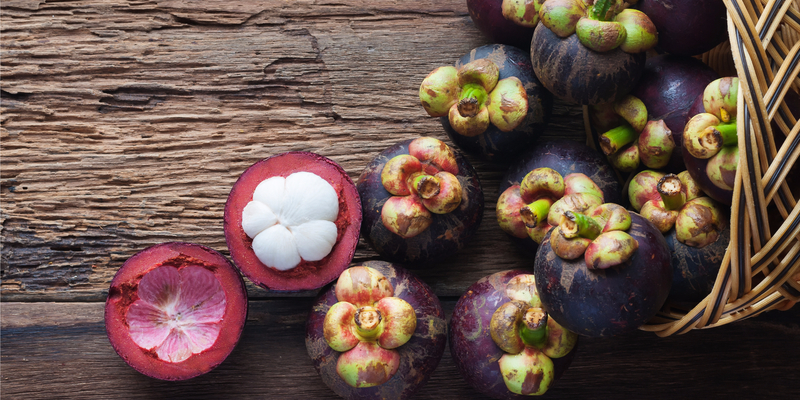The Health Benefits of Mangosteen
This month Mangosteens are in season! One of the lesser known fruits, we wanted to share more about them and get them in your kitchen! In this post, we take discuss some of the potential health benefits of Mangosteen.
Fruit Characteristics
The fruit is reddish or dark purple in colour. It’s made up of three major parts: the deep purple rind; the white edible flesh which is segmented like oranges and the seeds, found within the flesh. The seeds are extremely bitter in taste and are inedible while the flesh has a soft fragrance with a sweet taste. The outer shell or rind of the fruit (called the pericarp) is rather hard, yet can be opened easily.
Nutritional Value
The fruit is rich in water, energy, protein, carbohydrates and fibre. Essential nutrients such as calcium, iron, magnesium, phosphorous, potassium, zinc, copper and manganese can be found in abundance in a mangosteen. It also contains vitamin C, B6, B12, A; and, riboflavin, niacin, pantothenic acid, folate, folic acid, carotene and cryptoxanthin.
Health Benefits
Anti-cancer: The fruit contains xanthones, which inhibit cell growth and are being developed to prevent cancer or used in combination with anti-cancer drugs for beneficial effects.
Anti-inflammatory: Research has demonstrated that the extracts of mangosteen have anti-allergy and anti-inflammatory properties and inhibit the release of histamine and prostalgin which are associated with inflammation in the human body.
Healthy Skin: It helps reduce the risk of various conditions such as skin inflammation, skin ageing, eczema, allergies and bacterial infections.
Health Immunity: Because it’s so rich in a multitude of minerals and vitamins, it boosts the immune system. Protecting the body from various health ailments that weaken the immune system.
Medicinal Use: People from Southeast Asian countries have long use Mangosteens for medicinal use because of its anti-bacterial and anti-inflammatory properties. The leaves and bark of the tree can be mixed with other medicinal herbs and applied to the wounds for a faster recovery. The medicinal drink can be prepared by boiling the leaves and the bark of the tree.
Other Uses
Apart from the various health benefits, mangosteen is also useful for other commercial purposes such as whitening (mangosteen is a key ingredient in many whitening products in Asia) or chew sticks found in Ghana. The wood is also used for making rice pounders, handles and other furniture throughout Asia.
How to select and get more Mangosteen in your diet
- Pick fruit with less seeds and more fleshy segments. Choose the fruits which have the highest number of stigma lobes at the apex (the little green stuff at the top on the outside of the fruit).
- Fresh mangosteen fruit can be eaten as a dessert.
- The juice including the flesh and pulp can make a great healthy and refreshing drink.
- It can also be made into jams.
- Mangosteen is also available in tablet or capsule form, and can be taken as a supplement.
- Apart from the fruit, the seeds are also edible which can be consumed after roasting or boiling.
